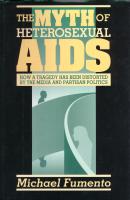Michael Fumento
Factual · Powerful · Original · Iconoclastic
The AIDS Numbers Racket — Chapter 37
January 01, 1988 · Michael Fumento · National Review · AidsAndy Warhol didn’t just say that in the future everyone would be famous for 15 minutes. By making his own fame ride on giant paintings of Campbell’s Soup cans, he proved it. It is now the future, and with Roper polls indicating that no magazine and newspaper articles are read by more of the public than those on AIDS, the ticket to that promised quarter-hour is most cheaply bought by proclamations of fresh news about that discase. Especially bad news.
 Messrs. Kevin Hopkins and William Johnston, both researchers at the Indianapolis-based
Hudson Institute, have caught the eye of the media by criticizing the
Centers for Disease Control (CDC) estimate regarding the number of Americans
infected with the AIDS virus (HIV). The Hudson report, which was endorsed
by President Reagan’s former science advisor Dr. George A. Keyworth, suggests
that from 1.9 million to three million Americans were infected with the
AIDS virus by the end of 1987, more than twice the CDC estimate of 945,000
to 1.4 million. The report also argues that the total includes 200,000
to 500,000 heterosexuals who are not intravenousdrug abusers (IVDAs),
many times the official estimate.
Messrs. Kevin Hopkins and William Johnston, both researchers at the Indianapolis-based
Hudson Institute, have caught the eye of the media by criticizing the
Centers for Disease Control (CDC) estimate regarding the number of Americans
infected with the AIDS virus (HIV). The Hudson report, which was endorsed
by President Reagan’s former science advisor Dr. George A. Keyworth, suggests
that from 1.9 million to three million Americans were infected with the
AIDS virus by the end of 1987, more than twice the CDC estimate of 945,000
to 1.4 million. The report also argues that the total includes 200,000
to 500,000 heterosexuals who are not intravenousdrug abusers (IVDAs),
many times the official estimate.
Scary stuff, to be sure. And the media dutifully reported the bottomline figures, without going into the theory behind them.
In this case it must be conceded that the media weren’t given much theory to work with. Instead, most of the Hudson report is devoted not to explaining its own calculations but to criticizing other theories. It notes, correctly, that single theory yet offered can deduce anything near an exact estimate of nationwide seroprevalence. All are skewed in some direction or another, and attempts to compensate only amount to sophisticated guessing. But the theories they criticize at least provide a basis on which they can be evaluated, and on which their numbers can be recalculated using other variables.
By contrast, the Hudson theory is what mathematicians call "black boxing" — throwing numbers into a box and pulling out whichever ones are suitable.
The authors’ method of figuring total infections has two parts. First, they calculate backward to find out how many people were infected by 1984. By using the present number of AIDS cases and the rate at which infections progress to AIDS, one may estimate how many infections there were a few years ago. (An estimate for any time more recent than 1984 or 1985 really isn’t possible since almost no infections develop into AIDS in the first two years.)
This approach is straightforward. It is like deducing ftom a car’s current position and a knowledge of its rate of speed — say, sixty miles an hour that an hour earlier it was sixty miles further back on the highway.
What makes its application to seropositivity estimation difficult is that: 1) no one knows exactly how many AIDS cases there have been (the CDC has estimated that under-reporting could hide as many as 20 per cent of cases), and 2) the progression rate isn’t etched in stone either, although several studies seem to have formed a fairly strong consensus. (The report offers a table, which happens to be correct, based on an average of four studies. It shows cumulative rates of 3 per cent at three years, 20 per cent at six years, and 45 per cent at nine years, meaning that at nine years after infection we can expect 45 per cent of seropositives to have developed AIDS.)
Unfortunately, the authors are more than a little confused. At first they state (correctly) that "if the assumed rate of progression is faster than the actual rate, then the predicted number of HIV infections will be lower than it actually is."
Thus, if the assumption that our hypothetical car was going sixty proves false and indeed it was only going thirty, then its starting position wasn’t sixty miles back, it was only thirty. Yet later the authors state that "the more severe the underestimate of the progression rate , the greater the number of historical infections there will be." This is the opposite of what they earlier stated and the opposite of the truth. It could be that they are confusing progression rate with median incubation time of the virus (shown by the table referred to above as slightly over nine years), which has been repeatedly underestimated.
Since they don’t bother to show their calculations, we can’t be sure which formula they used, but it appears to be the latter. Thus the basis for the figure which the Hudson report uses to show infections as of 1984 — as high as 1,220,000-is fatally flawed.
By contrast, Dr. Joel Hay, a senior research fellow at the Hoover Institution, has used progression calculation to establish only about 700,000 infections as of 1988.
Having established (incorrectly) a figure for infections as of 1984, the Hudson report thence seeks to establish how widely the epidemic has spread since. We are given the results of three scenarios, which estimate the spread as being anywhere from several hundred thousand infections to over two million. Yet we are given absolutely no information about what those scenarios consist of. For all we know, they are sheer guesswork.
One cannot directly attack such ghostly assertions, yet it can be stated that all three, including the alleged "best case" for which the other two cases serve as foils, may be based on a fallacious assumption — that the epidemic is necessarily spreading at all. Continual sample blood testing among high-risk groups suggests that rates of new infections are extremely low; studies in San Francisco show less than 1 per cent yearly among homosexuals and 2 to 3 per cent among IVDAs. This, combined with attrition caused by AIDS deaths as well as non-AIDS-related deaths among infected persons, means the overall percentage of the population that is infected may be holding still or even dropping.
In fact, testing of military recruits and first-time blood donors has shown no increase in infections over the last two years. While it’s true that these groups are not fully representative of the general population, the self-selection factors that make them different can be assumed to be constant, and therefore there’s no reason to think that a significant overall increase in seropositivity would not also show up in their ranks.
Support for the estimated 200,000 to 500,000 non-IVDA infected heterosexuals is no less sketchy. Cited approvingly are such sources as Masters and Johnson, whose survey sample we are told "was carefully selected," notwithstanding that their sample methodology was so haphazard as to draw comparison to Shere Hite’s.
Cited also is a study conducted by a sexually transmitted disease (STD) clinic in Baltimore showing high seropositivity among non-IVDA heterosexuals. We are not told that this study gave the highest rate of any such study in the nation (which is why it is the only one the Hudson report bothered to cite) or that it is the only such study where tested individuals were not reinterviewed upon being shown to be infected. (The importance of re-interviewing is that people will initially deny taboo practices such as homosexual acts and drug abuse until they are informed that they are infected, and are thereupon questioned by a well-trained, sympathetic interviewer. New York City officials have found that two-thirds of seropositive men initially claiming that their only high-risk activity is patronizing prostitutes will, upon re-interview, confess to either homosexual acts or drug abuse.)
Even with these false authorities there is no attempt to apply any of the data directly. They are simply listed in the body of the report as a select hodgepodge of studies. Ignored are such authoritative studies as that of the New York City Department of Health which concluded, "In the city with the world’s highest reported incidence of AIDS, these results suggest that HIV infection was primarily limited to known AIDS-risk-group members and their sexual partners."
The tiny percentage of non-IVDA heterosexuals being detected in military and blood-bank testing — an estimated two per ten thousand and six per hundred thousand respectively — also directly contradicts the Hudson estimate that as many as one in three hundred non-IVDA heterosexuals is infected. Such massive numbers of heterosexuals walking around unknowingly infected would surely be showing up in blood sampling; they are not.
The Hudson Institute report is nothing more than pre-determined conclusions and free-floating speculations presented as science. Alas, to those who have neither the time nor the expertise to pore over the Hudson material and discover this for themselves, it is cause for neither derision nor humor but for fear. The plague of hysteria continues to spread.
